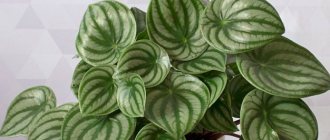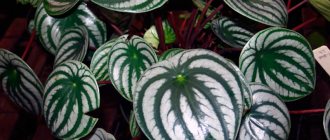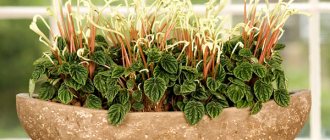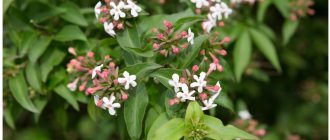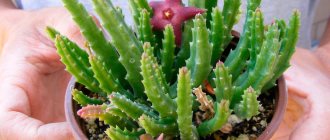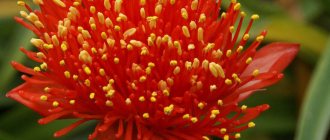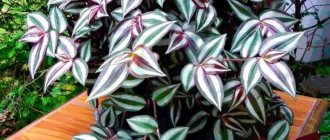Among the favorites of decorative foliage crops, all gardeners have one special plant in terms of texture, size, and character - peperomia. But the main advantage of this compact miracle has always been and remains diversity. Round or heart-shaped, medium-sized, but very impressive leaves captivate at first sight. And the effect of a curly or openwork rosette or pillow enhances the brightness of the colors and the beauty of the details. Peperomia really can be very different - sometimes simple, sometimes noble, outlandish or classic, sometimes completely different both in leaves and in the shape of the bushes. But these optimistic plants in any form have such a cheerful effect on the surrounding space that it is simply impossible not to fall in love with the beauty of their greenery.
Peperomia in the interior. © floradania
Houseplant Peperomia - description
As you can easily guess from the name, which contains the word “peper”, peperomia belongs to the Pepper family; its name itself translates as “pepper-like.” It is a perennial and evergreen plant, which means it will provide you with a bright, cheerful appearance for years to come.
Despite its tropical origin (and most tropical flowers, such as orchids, are very capricious), peperomia is absolutely unpretentious. Sometimes there is even an opinion that there are succulent species of this flower, but this, of course, is not so.
Succulents are easy to care for because they tend to grow in dry places and will not die if you forget to water them a couple of times, since they store moisture for a long time with the help of their thick, succulent leaves. Peperomia is unpretentious for another reason: it is epiphatic, that is, it can grow on almost any soil and survive in almost any conditions. Therefore, it is easy to care for even for novice gardeners.
What does peperomia look like?
This plant has many varieties (more than a thousand, by the way!), so their appearance can be very diverse. There are peperomia with red leaves or simply reddish, gray-silver, variegated (also variegated, that is, with a pattern on the leaves), and even the so-called “watermelon”.
What do all these types have in common:
- Peperomia is always short in stature, usually from fifteen to fifty centimeters;
- The main decorative element is leaves. They come in different shapes, can be pointed or round, like coins, but most often they are oval, slightly elongated, dense, leathery, covered with a waxy coating and therefore glossy.
The color of the leaves is varied, depending on the species, the presence of sun and moisture. Sometimes the leaves are velvety to the touch.
Peperomia can be either erect or creeping - ampelous (types of creeping peperomia are often used for hanging pots, therefore they are called ampelous).
Where it grows - the birthplace of the plant
South America, Asia, Africa. The native climate for peperomia is tropical, hot, humid.
How indoor peperomia blooms and what color it is
Yes, it blooms, but not very decoratively. The peduncles have the shape of thin spikelets, the flowers are faded and small. The main decorative element of peperomia is its leaves.
Is peperomia poisonous or not?
No, it's not poisonous.
The many-faced queen of room arrangements
It is no coincidence that for several years now peperomia have been called the favorite plants of modern interiors. Finding a plant that offers such a wide selection of different shapes, types and varieties is truly difficult. And at the same time, all peperomia are universally easy to grow and fit perfectly into any environment. Representatives of the genus peperomia owe their name not only to the similarity of the leaves to peppers (the plant in its classical forms cannot really be called anything other than pepper-like). Therefore, peperomia belongs specifically to the Pepper family ( Piperaceae ) . The diversity of peperomia is so great that it is not always possible to recognize the belonging of individual species to the same genus at first glance.
Peperomia is a genus of evergreen herbaceous perennials, in fact, the only common “obligatory” feature for which is thick, fleshy shoots. Depending on the species, they can be almost reduced, shortened, erect, lodging or even creeping. Moreover, the type of shoots directly determines both the use of plants and their appearance. But peperomias are valued not for the multitude of different growth forms, but for their decorative foliage, which is invariably attractive in any plant of this genus.
The leaves sit on fairly short petioles alternately or in whorls, arranged so densely that the shoots underneath are almost never visible. Fleshy, succulent, dense, they can differ among different species not only in size (from 1 to 15 cm), but also in shape (round, heart-shaped), surface texture (from glossy smooth-waxy to velvety, wrinkled, embossed) and , of course, the same color, which ranges from dark green to bright light green, brown, olive, purple, silver, not to mention numerous variegated combinations.
But all peperomia, without exception, have entire leaves. And with all this, peperomia are also able to bloom, releasing dense spikelets of inflorescences from perianth-free cream or pale green flowers, which, however, can hardly be called very attractive (but at the same time, flowering does not affect the beauty or density of greenery). Peperomia fruits can bloom and bear fruit, forming miniature dryish fruits that are easily separated from the “cob” all year round.
Sweet Peperomia (Peperomia blanda). © HiHort
Spotted peperomia (Peperomia maculosa). © floradania
Peperomia wrinkled, or Peperomia caperata. © floradania
How to care for Peperomia at home
It is important to properly care for any plant, since most often diseases appear due to improper care. Here's what you need to do to make your Peperomia feel healthy and happy:
What to do after purchase
The first step is to inspect the flower, if you have not done this in the store. Inspection is carried out for signs of diseases and pests. If the plant is healthy, and you are sure that your existing green pets are also healthy, you can add a new resident to them for permanent residence. If you notice signs of diseases, then move below to the diseases and pests section - it describes in detail how to deal with them.
Usually flowers are replanted immediately after purchase, since store-bought soil, as a rule, does not provide the new green resident with the required amount of nutrients.
However, with peperomia it depends on the time of year: you cannot replant in winter, since replanting is stress that the plant may not tolerate. In the fall it is replanted if it becomes cramped in the pot. The ideal time for transplantation is spring.
Lighting
Abundant, scattered. If you place it on a south window, it is advisable to slightly shade it with a curtain or place it behind another plant.
The flower needs eight to ten hours of sunlight daily, so from mid-autumn to the end of winter it is necessary to turn on ultraviolet lamps in the evenings.
Temperature
In summer and spring – +20-22⁰С, in winter the temperature can be reduced to 18⁰С. In general, peperomia is not capricious; it begins to feel bad only at temperatures below 15⁰C or above 27⁰C. However, 18-22⁰C is optimal for it.
It is important that the substrate is also warm (17-22⁰C), since hypothermia leads to freezing or rotting of the roots. In order for the substrate to retain heat better, it is advisable to use plastic rather than ceramic pots, since ceramics cool more easily.
Humidity
It is not critical, but no plant likes excessive dryness, so placing it near heating devices is still not recommended.
If you have a variety with velvety, fleecy leaves, you do not need to spray it, because moisture will be retained in the hairs. If the leaves are glossy and smooth, then you can spray them a couple of times a week.
How to water peperomia
With settled or boiled water (it is softer than just tap water and does not contain harmful elements), the water should be warm, but not hot (20-30⁰С, for the human hand this feels like “cool”). It is not recommended to use store-bought water.
In summer
From March to September, watering is done abundantly, since the substrate dries out quickly.
in winter
And from October to February it is moderate, because the substrate dries out more slowly. You should be guided by the top layer of soil: if it is dry and feels like crust to the touch, it means it’s time to water.
Fertilizer and feeding
It is not necessary to use them; it is easy to overdo it, and this leads to negative consequences for the plant. If you use it, then take a complex fertilizer for ornamental plants and apply it, halving the norms recommended on the packages.
Similar flowers
There are a huge variety of Peperomia varieties from which you can create beautiful flower arrangements.
If the grower likes the brightness of Rosso, then he may like the following varieties of bush Peperomia. Below you can see photos of similar plants.
- Peperomia Watermelon will, just like Rosso, delight the owner with the bright red-green coloring of the leaves.
- Peperomia Marble has another feature: burgundy rims and veins on the leaves.
- The tricolor has a beautiful white border.
- Peperomia Wrinkled has a bright, rich color and a glossy surface.
- Caperata Lilian is a little different from other Caperata - its flowers resemble lilies in shape.
Peperomia Rosso is an amazingly beautiful exotic flower, which is at the same time unusually unpretentious. The bright and unusual color of the leaves will delight any plant grower.
Reproduction of peperomia at home
Typically, to propagate a plant, you will need to cut off part of it. This is done with a sharp tool (scissors, pliers, pruning shears, a knife - whatever is convenient) so that you can cut off part of the plant in one movement, without the need to saw it off or break it off, since such a “ragged” wound will take longer to heal and is more likely to become infected.
The sections must be sprinkled with crushed activated carbon. This is also done for disinfection, as well as to speed up the healing of the cut.
The cuts are made diagonally, at an angle of 45 degrees, to make it easier for the mother plant to grow a new leaf or cutting to replace the one you took for the new plant.
Leaf
It's very simple: cut off a large, healthy leaf and transplant it into a small pot. The soil can be the same as the mother plant, or you can use seed soil (half leaf soil, half coarse river sand).
It is advisable to place the pot with the leaf in a warmer place than the mother plant - this will speed up growth. It is necessary to water periodically so that the soil does not dry out. Rooting will occur in three to four weeks.
Cuttings
Everything is the same as for rooting with a leaf, but instead of one leaf, a cutting is taken - a part of the stem with a pair of leaves and at least one node. These methods of reproduction are no different.
Growing from seeds
This is a more complex method. As a rule, propagation by seeds is used by professionals, because this method allows you to grow many flowers at once. Here's what you need to do:
Buy seeds or wait for the flower you already have to bloom and collect the berries left after flowering. Planting is carried out immediately after collecting the seeds, since the “fresh” they are, the higher the germination rate.
Plant the seeds in containers. There are many seeds, they are small, so they are planted in furrows at a distance of 8-10 cm from each other.
Composition of soil for seeds: half leaf soil, half coarse sand.
After planting, it is necessary to water the seeds with warm, settled water and cover with polyethylene or glass. Place in a sunny room with an air temperature of at least 25⁰C.
When the seed has hatched, it has two independent leaves - it is planted in a separate small container (an ordinary plastic cup will do) and placed in a sunny place. The composition of the soil is not changed, it is left the same (coarse sand and leaf soil). They are transplanted into mature soil when several pairs of leaves appear and the seedling gets stronger.
Transplanting Peperomia at home
You should prepare for the transplant in advance. You will need to prepare the soil (see composition below) and disinfect it: bake it in the oven at a temperature of at least 100⁰C (this is necessary to kill all possible pests), and then leave it for ten to fifteen days in a room that is well ventilated so that healthy microorganisms were restored there.
The procedure for transplantation is very simple:
- Place a new one next to the old peperomia pot.
- Fill it 6-8 cm with drainage - expanded clay, pebbles, broken bricks.
- Sprinkle new soil on top (2-3 cm).
- Remove the flower from the old pot. Inspect the root system: are there any rotten parts, does it look healthy.
- If everything is in order, then place the plant in the center of the new pot and fill in the remaining soil.
- If there are rotten parts, it’s good that you noticed in time, just remove them with scissors and sprinkle the cuts with ground crushed coal, and only then transplant them into a new pot.
- After 3-4 days, water.
When to replant
The optimal time of year for transplantation is spring and summer. Transplantation in winter and autumn is extremely undesirable, since the plant may not withstand stress. A young plant (up to 4 years old) is replanted annually, after 4 years - as necessary.
Reasons for transplantation:
- Most often, they are replanted because the peperomia has grown out of its pot. This can be determined by the roots: if they look out of the pot, it means it’s time to replant.
- Also, replanting is often carried out to save the plant from disease or pests, because often it is the soil that harms it: infested with pests or waterlogged, oversaturated with fertilizers.
Priming
You can buy ready-made soil for peperomia or make it yourself: three parts of leaf soil, one part each of peat, compost and coarse sand. You will also need drainage, because the flower does not tolerate waterlogging.
Pot
A plastic pot is desirable; it retains heat better, which reduces the risk of overcooling the soil.
The pot size is tall and narrow to accommodate the thick layer of drainage and root system of the peperomia. If you are replanting a peperomia because it has outgrown the previous pot, the new pot should be about a third or half larger in diameter than the previous one.
Reproduction methods
The plant is propagated by dividing the bush, cuttings and leaves. These are methods known to all flower growers that do not require detailed description. You can root the petioles and leaves in the parent pot at a temperature of 24-25 degrees.
The roots appear after 3-4 weeks; you will learn about their appearance when the young plant begins to grow new leaves.
For cuttings, a shoot with one node is enough
Rooting an adult leaf Reproduction by dividing the bush
For reference. At home, it is very difficult to propagate peperomia by seeds, since they are very small and require ideal conditions for germination. Therefore, this method is rarely used.
Peperomia diseases with photos and their treatment
They often say not “plant diseases”, but “leaf diseases”, but strictly speaking, this is wrong, because if the leaves turn yellow, are deformed, curled, or become covered with spots, this means that something is wrong in the plant itself, but on the leaves it's just reflected. Plants often get sick due to improper care. In the case of peperomia, this happens as follows:
- Sunburn of leaves . It appears in the form of brown spots on them. Everything is simple here: you need to move the peperomia into the shade or at least organize a barrier between it and the sun (for example, in the form of a curtain). The plant will recover on its own.
- Excess fertilizer . It manifests itself as yellowing of the leaves and the appearance of brown spots on them. What to do with this: remove the fertilizer, let the plant digest what it already has; in particularly advanced cases, replanting is required, since the fertilizer is absorbed into the soil.
- The plant suffers from heat or, conversely, from cold, or from lack of moisture . Because of this, the leaves dry out, wrinkle and fall off. If this happens, then analyze the conditions in which it is contained and eliminate deviations from the norm.
- A sharp drop of leaves while outwardly appearing absolutely healthy indicates hypothermia.
- Overmoistening . It is manifested by the appearance of bubbles on the leaves. What to do: Reduce watering by half until the peperomia returns to normal.
- Root rot . Appears due to waterlogging of the soil. What needs to be done: replant the plant, during replanting, wash the roots and remove rotten parts.
As you can see, there are few diseases, most of them appear due to care errors. This is good, it means that the peperomia plant itself is healthy and will not wither away for no reason. The main thing is to care for it properly.
Groups and varieties
More than fifty varieties of peperomia are actively used in indoor floriculture. And they are all different from each other, so it is difficult to believe in their close relationship.
They are divided into species according to the shape of the plant into: bush-like, erect and hanging.
Three main groups of peperomia
Bush-like
Common features are the small height of the plants (10-15 cm) and the shape of the bushes, reminiscent of a fluffy cap. Inflorescences on long petioles rise above them like feathers on a hat.
This group includes:
- Peperomia corrugata is distinguished by corrugated leaves and shortened stems, thanks to which the plant looks compact and very lush. It is very demanding on heat and the quality of the soil, which must be loose and nutritious. The color of the leaves may vary:
Dark green
Green-burgundy Brown-violet
- Peperomia lilian differs from the wrinkled one only in its inflorescences, with its shape reminiscent of snow-white lily flowers. The leaves are the same as those of Peperomia corrugata - heart-shaped, with recessed veins and a glossy waxy coating.
Peperomia lilian
- Peperomia Rosso is an unusually beautiful plant with long and large two-color leaves. They are green above and burgundy-red below. On stems they grow in bunches that look like fantastic stars. Rosso blooms rarely and for a short time, sending up pinkish arrows on red petioles from the lush bush.
Peperomia rosso
- Silver peperomia is one of the most unpretentious species. It is not as demanding of heat as its relatives, since it grows naturally in the northern part of the continent. Its heart-shaped leaves are light silver in color, the veins are dark green, and the long petioles are purple.
Peperomia silver
- Peperomia gray gets its name because of the felt-like edge on the leaves and shoots, which is associated with gray hair. This is a fairly tall plant, reaching half a meter, with sparsely scattered leaves.
Peperomia gray
Peperomia indoor pests
Peperomia pests are quite standard; many indoor plants suffer from them. It is important to know the following:
Firstly, if peperomia diseases, as a rule, begin due to improper care (for example, waterlogging or too much fertilizer), then pests often appear because you are simply unlucky. For example, you may accidentally pick up an insect on your shoes when returning from the street.
Therefore, it is important to periodically inspect your indoor plant for insects in order to immediately take measures to eliminate them before they have time to cause significant harm to the peperomia. Do not forget also that not only the ground parts need to be inspected, but also the soil in which the flower grows, since some pests hide there.
Secondly, pests most often appear in dry and hot microclimates, and they also love dust. Therefore, try to maintain order in the room where peperomia grows, periodically wipe the windowsill and window so that there is not a lot of dust around the flower. This is especially true for plants that live near heating devices.
Thirdly, most often pests adapt to the conditions in which they live and, sadly, do not even become susceptible to poison. Therefore, in order to remove pests, especially if they have already multiplied and are seriously harming the plant, you will have to use several means and alternate them.
So, what pests do peperomia have:
- Thrips
Symptoms: beige specks of dead tissue on the leaves, then the leaves become covered with a sticky silvery coating and die.
What to do: treat with several types of insecticide (two weeks between treatments), this will help get rid of the larvae. If adults have already appeared, you will have to hang fly tape around the flower and catch them.
Prevention: periodically water the peperomia with hot water and spray it with an infusion of fragrant herbs (for example, dill, parsley) to repel thrips.
- Mealybug
Symptoms: white lumpy coating, similar to cotton wool, then deformation and drooping of the leaves.
Reason for appearance: unlike other pests, mealybugs love moisture and cold, so they often appear as a result of excessive watering and low temperatures. Another reason is contaminated soil; here you could simply be unlucky in the store. Accordingly, prevention is careful adherence to the rules of plant care.
What to do: replant the peperomia, because if there are mealybugs, it means that the soil is most likely also contaminated. During transplantation, you need to wash the roots and inspect them; if there are rotten parts, remove them. After transplantation, it is necessary to treat with two types of insecticides (the break between treatments is ten days).
- Spider mite
Symptoms: a characteristic coating resembling very thin threads of cobwebs, usually on the lower parts of the plant. Then the leaves turn yellow and fall off, the plant becomes deformed and looks weak.
What to do: it is necessary to create high humidity conditions for peperomia, since this is what spider mites are most afraid of. This can be done as follows: first, the peperomia take a shower with soap to wash off all the insects and all the cobwebs, and then cover it with plastic film or glass, creating a greenhouse.
If this does not help and the ticks survive, then insecticide treatment is carried out.
Prevention: spraying, since spider mites like dryness and do not like moisture.
- Nematodes
Symptoms: brownish, vaguely shaped spots on the leaves, followed by wilting and death, as well as deformation and swelling of the roots.
What to do: place in a bathtub filled with hot water for half an hour. If this does not help, then the plant will have to be thrown away.
Preventive measures: once a week, irradiate the flower with a quartz lamp.
- Shchitovka
Symptoms: leaves turn yellow, brown growths appear on them, then the leaves fall off.
What to do: thoroughly wipe the indoor flower with cotton pads or a soft cloth soaked in a thick soap solution, then rinse under a hot shower. This is necessary in order to wash away the adults. Then you need to make a greenhouse - cover the flower with a plastic bag or glass.
If this does not help, then start treating with different types of insecticides, constantly alternating and changing them, since the scale insect is dangerous precisely because, thanks to the shield on its back, it is almost impervious to chemical drugs.
Prevention: regularly inspect peperomia, because the sooner you find the scale insect, the easier it will be to remove it.
Possible problems
If not properly cared for, indoor peperomia can cause various problems, for example:
- Flying leaves . Most often, a bush sheds its leaves when a clod of earth in a pot dries out or if the room is very cold.
- The tops and edges of leaf blades turn brown . This is due to the fact that the temperature in the room either dropped sharply or experienced temperature changes. This can also happen due to a draft.
- Rot appeared on the foliage and shoots . This is due to regular stagnation of fluid in the root system. Symptoms are most active if the bush is in the cold (below 16 degrees) and is constantly over-watered.
- The foliage withers and wrinkles . Do not expose the bush to direct sunlight. If the flower is on a southern windowsill, then burns may also form on the surface of its leaf plates.
- Harmful insects . If the flower is not properly cared for, then thrips, scale insects, mites, nematodes and mealybugs can settle on it.
Popular types of Peperomia with names and photos
As already mentioned, there are more than a thousand varieties of peperomia. Here are some of them.
Bush-like
These are terrestrial varieties, that is, they do not creep, but stand upright. They cannot be used for hanging pots, but they look great on a windowsill.
Shriveled or caperata
A common feature of all “wrinkled” varieties is deep grooves on the leaves, because of which they really appear wrinkled and ribbed.
The most popular varieties:
Rosso is a small, lush, rounded bush of a large rosette of dark green leaves with silvery wide lines, slightly pointed. The bush looks like a large, lush, green rose.
Lilian is one of the few varieties that are decorative not only with their leaves, but also during flowering. They bloom in a small bush of a dozen thin, white, fragile bell-shaped flowers.
Shumi Red is distinguished by its colors: black and purple, even a little scary, and will fit perfectly into a Gothic-style interior.
Silver or watermelon
The leaves of this variety really are very reminiscent of a round, juicy watermelon with neat, longitudinal stripes dividing the leaf plate into peculiar even slices.
Gray-haired (peperomia incana)
There are no longer ribbed leaves - on the contrary, they are smooth, round, dark green in color with a noble silvery coating. Fleecy variety, velvety to the touch.
Magnolifolia
One of the most popular varieties with very bright, glossy, elastic leaves that you just want to touch - they are so bright, cheerful, making you remember summer even in winter.
Clusielifolia
The most popular varieties of clusielifolia peperomia:
Jelly is an unusual variety, quite miniature; even a relatively small pot is enough for it. The leaves grow in different directions straight from the ground, they are bright green in the middle, but edged with an uneven yellow stripe, and their very edges become pink.
Red Margin is a more reserved variety with a small number of shoots, but they are large, deep, noble dark green in color with a pinkish border along the edge.
Multicarpal or polybothria, raindrop
The peculiarity of this variety: it has rather long stems for a peperomia, there are several of them, and on each there is a small rosette of perfectly round malachite-green leaves. The result is an unusual composition.
Tupolifolia
The most popular peperomia of this type:
Green Gold is a variegated variety with a green core and a wide bright yellow border.
Pixie lime - distinguished by graceful, oval, slightly pointed leaves of a delicate golden-green hue, glossy, without patterns.
pitted
It is similar to the “watermelon” variety, but the leaf plates are smaller, but more abundant, and the stripes dividing the plate into slices are thinner, and the slices themselves are smaller.
Marble
Another variety “from the same opera”. The difference between this and the previous one is larger, rounded leaves, wider silvery stripes, which is why the variety appears not green, but white-green.
Spotted
This variety has few leaf blades, but they are very large, rich green in color, covered with a waxy coating, glossy, with thin white veins.
Metallica Colombiana
This variety has many leaves, they are smaller than other varieties, the color is black and burgundy with a silvery core.
Piccolo Gang
A variety that grows as a miniature bush. Similar to watermelon, it will look great on your desktop - casual, elegant, not too bright, but lifting your mood.
Ampelnaya
Ampelous varieties of peperomia are creeping ones, which are most often used for hanging pots for summer decoration of a cottage or balcony. It looks really nice.
Creeping
This variety has many small, rounded leaves that emerge from the pot like green foam. If you look closely, you will notice that the leaves are decorated with a white pattern.
Head or glabella
This variety is not as abundant, but has a beautiful, bright green shade of small, glossy, rounded leaves.
Round-leaved or rotundifolia, coinifolia
This variety can be grown as a bush at first, because the young plant will grow straight, but with age it will turn into a real green waterfall, beyond which you can’t even see the pot.
Climbing or skandance variegata
This variety has small, rounded green leaves with golden edges. Looks like a green and gold mane running down the pot.
Pereskilifolia or small-leaved
The most popular varieties:
Angulata looks great both in the country and in the office, since this variety grows less abundantly, more restrainedly, not with such a lush mane as the previous ones, but its leaves are larger, elongated, built-up, with barely noticeable lines.
Rubella is an unusual variety: the outer surface of the leaves is soft green, but the underside is dark pink, almost red.
Creeping or prostrate
The bush is very low, grows purely downwards, so it can even reach the floor or furniture. The leaves are a delicate light green shade. Perfect for light-colored interiors.
Succulent
These varieties tend to have thicker and more elongated leaves, although they resemble succulents, although peperomia is not actually one of them.
Chisel-shaped
It looks quite unusual: a lush bright green rosette growing in all directions with many long, sharp shoots similar to empty pea pods. The most common:
Happy Bean is a small but lush dark green bush that looks great in the office or on the balcony.
At first glance, it is difficult to mistake Nivalis for a peperomia: it grows in a spikelet studded with small soft green thick leaves.
Graveolens
The variety is distinguished by many thin, sharp-shaped shoots with a dark core and rich burgundy edging.
Columella
A creeping variety, but instead of a bush there are many spikelets, studded with strong small leaves tightly adjacent to each other.
Whorled
A miniature variety with a long stem and rounded leaves around it, all this together forms an unusual composition.
Popular varieties
The following varieties are in great demand in Russia:
Peperomia Rosso
Subshrub, the result of the work of scientific breeders. Grows up to 20-24 cm in height. Leaves are tufts attached to the main stem. The upper part is rich bright green, facing the sun's rays, the lower part is reddish. Caring for Peperomia Rosso at home is not particularly difficult.
Peperomia Caperata
Evergreen perennial plant. The leaves of Peperomia (peperomia) Caperata are heart-shaped, up to 4 cm long, the stems are reddish or short green. The plates are corrugated, one-piece with deep burgundy veins. When flowering, thin spikelets with small flowers appear.
Appearance of Caperata Peperomia
Peperomia Prostrata
A small mix plant that will look original in pots with a diameter of 5 cm. This is a decorative variety. Prefers moderate moisture, but is quite light-loving. Belongs to a deciduous crop. Reaches a height of 100 cm, but is quite squat, climbing ampelous plant.
Peperomia chisel
Pereklefolia succulent with densely spaced sessile leaves on short and thick stems. Visually, the leaf blades look like they are bent in half. Sunlight easily enters the corners of the leaves thanks to the upper cut with a transparent surface. In summer, short peduncles and inflorescences in the form of panicles with greenish flowers appear at the tops of the shoots.
What does a chisel flower look like?
Peperomia coinifolia
An ampelous type of creeping peperomia - an indoor flower. It will be an excellent decoration for a veranda or window opening. It grows with round leaves of a light green color, tightly seated on short petioles. Red thin shoots up to 2 cm in length. Peperomia roundifolia will look like openwork balls and please the eye. The coin-leaved peperomia has no dormant period, so it pleases with its beauty all year round.
Peperomia bushy
It grows in pieces up to 15 cm in height. It is formed from leaves in the form of a thick cap. During the flowering period, inflorescences appear from the spikelets.
Peperomia graveolens
A bright, visually attractive multi-taste succulent with beautiful leaves. The upper surface is light green, the lower surface is ruby or burgundy. The leaves grow, curling towards the main shoot. Sometimes the flowers of indoor ficus peperomia grow similar to corals.
For your information! If you cover the soil in a pot with pebbles and plant a blunt-leaved flower, you can achieve an extraordinary result and a great resemblance to a sea life.
Peperomia variegata
This flower in nature is found with reddish, beige, dark green, silver leaves. A variety of clusielifolia peperomia with original variegated foliage in three colors. A popular flower with a dark green color and leaves edged with red for added definition. The indoor plant is miniature, so it will suit any home interior or for creating different flower arrangements.
Variegated plant species
Indoor peperomia (bronze, variegated, Ferreira, bush-shaped, coin-leaved, Happy) can have many colors and leaf shapes. If you care for it correctly, it will definitely become a favorite and take its rightful place in the collection of home flowers. Moreover, the plant is beneficial, releases phytoncides and disinfects the air in the room. This is important in rooms where frequently ill children live.
What does the peperomia flower bring into the house: benefits and harms
The main benefit of this plant for the home is air purification. Peperomia has large, bright green leaves that disinfect the air, absorb carbon dioxide and other harmful fumes, and in return produce pure oxygen. Therefore, it is recommended to plant this home flower for people who suffer from respiratory diseases, often get colds or often have headaches - the purified air around them usually has a positive effect on their well-being.
As for superstitions, here are the reviews about peperomia as follows:
- Peperomia has bright, positive energy. They say that it purifies not only the air from harmful fumes, but also the thoughts from anger and irritation. In a house where peperomia grows, family members show more warmth and tenderness towards each other.
- The exception is the varieties of peperomia with pointed tips of the leaves (the owners of this shape are rare types of wrinkled peperomia), the opinion about them is the opposite: it is believed that they attract evil, negative energy.
- They say that peperomia attracts change. For the better, of course.
- The plant is also said to help make the right decisions. This phenomenon may also have a completely medical, scientific explanation: peperomia purifies the air, and when a person breathes clean air, he thinks easier and more clearly. Well, from the point of view of superstition, one might think that peperomia inspires the owner with the right thoughts and attracts positive energy to him.
- From the point of view of Feng Shui teachings, peperomia is a plant full of feminine soft passive energy “Yin”. This means that it helps to soften a harsh character, extinguishes quarrels, and encourages people to be more diplomatic and gentle towards each other.
- However, this also means that peperomia extinguishes the love fervor of the spouses, making their married life cold and apathetic. Therefore, it is advisable not to place such plants in the bedroom, but the living room or kitchen is perfect.
Plant characteristics
Peperomia glabella is part of the Pepper family. From ancient Greek peperi is translated as pepper, omos – similar, and glabella means naked, heady. It is also called Peperomia Cypress.
In the natural environment, there are about 1000 varieties of peperomia. About 30 species have adapted to growing indoors. Its habitat is tropical rainforests. The flower can be found in the wild in Asia, America, and India. It grows on tree trunks, snags and in loose peat soils. It is an epiphyte, that is, it coexists with other species, using them only as support.
Peperomia golovata belongs to the ampelous variety; it is characterized by creeping or drooping shoots. The maximum length of the stem reaches 22 cm. The leaf blade is oval, close to a circle in shape. The smooth and fleshy leaves are arranged in an alternate order and are characterized by a bright green color. The root system is branched and superficial.

